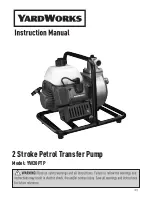
4
¾
Three-position manual control. Double effect cylinder. Type: HAM _ _ 4 _.
o
Connect the cylinder’s forward hose (pressure) to outlet ‘A’ of the distributing valve, and the return hose to outlet
‘B’.
o
When the lever is set to position ‘A’, the cylinder moves forward. When the lever is in position ‘C’, it maintains the
load in its current position, and when the lever is set to ‘B’, the cylinder returns, thanks to the pressure applied by
the oil distributed by the pump.
¾
Two-position electrical control. Single effect cylinder. Type: HAE _ _ 1 _.
o
The distributing valve has a single outlet for connection to the hose.
o
When the UP button of the remote pendant is pressed, the cylinder moves forward. When the button is released, it
moves back, thanks to the action of the spring or the weight of the load itself.
¾
Three-position electrical control. Single effect cylinder. Type: HAE _ _ 2 _.
o
Connect the hose to outlet ‘A’ (plastic plug). When the ‘UP’ button on the remote pendant is pressed, the cylinder
moves forward. When it is released, the cylinder maintains the pressure level and the load remains where it is.
When the ‘DOWN’ button is pressed, the cylinder returns thanks to the action of the spring or the weight of the load
itself.
¾
Three-position electrical control. Double effect cylinder. Type: HAE _ _ 4 _.
o
Connect the cylinder’s forward hose (pressure) to outlet ‘A’ (upper) of the distributing valve, and the return hose to
outlet ‘A’ (lower). When the ‘UP’ button on the remote pendant is pressed, the cylinder moves forward. When it is
released, the cylinder maintains the pressure level and the load remains where it is. When the ‘DOWN’ button is
pressed, the cylinder returns thanks to the pressure applied by the oil distributed by the pump.
¾
Make sure that the voltage level in the mains coincides with that specified for the machine.
3.2 CHECKING THE CORRECT FUNCTIONING OF ALL MACHINE PARTS
¾
Replace the transportation plug with the ventilation plug (supplied in a plastic bag).
¾
Check the tank level.
¾
Connect the mains electricity supply to the terminal strip in the electrical cabinet.
¾
Make sure that the remote pendant is deactivated and that the manual control is set to either ‘C’ or ‘T’.
¾
With HAE-type electrical control pumps, rotate the electrical cabinet’s side switch to position ‘1’. A green pilot light will come on.
Press the electrical cabinet’s green button to start the motor.
¾
Check that the direction of rotation coincides with that indicated by the arrow on the electric motor lid. If the directions do not
coincide, stop the motor (by pressing the red switch), set the side switch to ‘0’ and swap the two cables around in the terminal.
Repeat the operation and check that the direction of rotation is now correct.
¾
With HAM-type manual control pumps, press the black button on the circuit breaker box to start the motor. Check the direction of
rotation as explained in the previous point.
¾
With electrical control pumps, when the ‘UP’ button on the remote pendant is pressed, the cylinder piston moves forward once
the hose has filled with oil. The piston moves back when the ‘DOWN’ button is pressed.
¾
Practise moving the piston back and forth.
¾
With manual control pumps, when the lever is set to position ‘A’ or ‘P’, the cylinder piston moves forward once the hose has filled
with oil. The piston moves back when the lever is set to position ‘B’ or ‘T’.
¾
After making sure that no one is located in the danger zone, carefully extend the cylinder as far as it will go.
VERY IMPORTANT:
BEFORE DOING THIS, MAKE SURE THAT THE CYLINDER OR HYDRAULIC TOOL IS DESIGNED TO WITHSTAND
ALL THE PRESSURE AT THE END OF ITS STROKE.
¾
The point of the pressure gauge is only subjected to pressure when the remote pendant is activated or the manual control is set
to position ‘A’ or ‘B’.
¾
Use a pressure gauge at this point to check that the internal safety valve is set correctly to 700 bar.
¾
If you wish to check the pressure of an installation without pressing the remote pendant (open centre, ‘P’ connected to ‘T’ and
forward and back movements blocked) or with the manual control set to ‘C’, you should place the pressure gauge and its
corresponding joint in the output of the distributing valve.
¾
If you do not press the remote pendant or the manual valve control is set to ‘C’, the distributing valve’s check valves will maintain
the pressure in the circuit.
¾
If the proposed operating pressure is less than 700 bar, use the external pressure regulator.
¾
Use a spanner to loosen the lock nut and a screwdriver to loosen (anticlockwise – reduces pressure) or tighten (clockwise –
increases pressure) the adjustment screw. Use a pressure gauge to check that the desired operating pressure has been
reached, and then block the adjustment screw using the lock nut to prevent unwanted loosening due to vibrations.
¾
Check for leaks when working under pressure and make sure that the machine and the installation are working correctly in
accordance with the established application.
¾
The above steps should be repeated as many times as necessary, until the operator has become familiar with the working of the
machine.
ALL THESE CHECKS SHOULD BE CARRIED OUT WITHOUT A LOAD. THEIR AIM IS TO ENABLE OPERATORS TO BECOME
FAMILIAR WITH THE WORKING OF THE MACHINE.
In HAE-type pumps with electrical control, check the correct working of the emergency stop mechanism: the RED EMERGENCY
BUTTON in the remote pendant.
Summary of Contents for HAM5524
Page 7: ...7 6 DECLARATION OF CONFORMITY ...
Page 8: ...8 ...
Page 9: ...9 ...
Page 10: ...10 ...
Page 11: ...11 ...





























